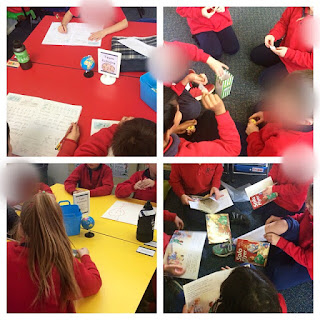I was recently contacted by the people at Twinkl to review some of their Australian resources. They kindly offered me a free subscription so I can look at all of their resources, and offer my own opinions about them.
I will start off by saying that I don't love worksheets. I do use them, but not everyday, and I prefer hands-on activities. So, I was very glad when I started looking through Twinkl's resources and saw lots of resources that are not just 'busy work' worksheets. They have displays, which are colourful and eye catching, packs of cut-and-paste resources for sequencing and sorting, and games/activities to print and continue to reuse.
The resources I'm going to share are some of their English resources designed for grades 3 and 4.
Home Reading
If you're looking for a new Reading Log, this one looks great! I particularly liked the column where students can list their emotions about their reading - this helps with reflecting on their reading, and can help a teacher to understand how reading homework is going at home.Narrative Writing
Two resources caught my eye for Narrative. The Narrative Writing Prompt Flashcards and the Narrative Writing Student Checklist.
I loved that the prompt flashcards have photos on the cards along with the text to give more inspiration and support for coming up with interesting narratives. I can definitely see my students using these appealing cards to help with their writing ideas.
I'm always looking for ways for students to be self-reflective and to review their own writing before showing it to me, and using this checklist would support that. I like that I could hand them out before, during or after my students' complete their narrative writing and they could be using them to make sure their narrative writing is high quality. It prompts them to think about the important elements of narrative writing. I did think it was interesting that one item on the list is "My story has a believable but interesting problem". I'm not worried about believable problems, I'm more interested in their creativity and how they solve the problem in the story.
Procedural Writing
I was disappointed that there weren't any grade 3/4 procedural writing resources because that's our next writing focus. The procedural writing resources that were available would be more suited to the younger grades. The only resource that will probably be useful is the Features of Instructions and Procedures Poster, but only as a reference.
Speaking and Listening
My school has been focusing on oral language and the Speaking and Listening curriculum for the last 6 months, so I was curious to see what resources were available on Twinkl for these areas.
They have created an easy to use Speaking and Listening Observational Rubric for different year levels, and I printed the grade 3 rubric to look at. I like that it refers to the Content Descriptions for the Australian Curriculum, however I'm in Victoria and we're using the new Victorian Curriculum so the codes are slightly different. But, as a simple checklist to assess how students are going with this curriculum area it would be very useful.
The Oral Presentation Rubric for Year 3 would have been so useful for me last term!! Our students had to plan and present a presentation about their favourite book, and if I'd had his rubric it would have made assessing so easy. I like that it lists different elements to assess, as well as a star grading scale, and it has the Australian Curriculum links on the bottom.
Literacy Group Activity
The last resource is one that I'll include in my reading groups next term. We have been looking at ways to improve students' vocabulary, and I think the Word Challenge Worksheet would be great for that. I'm going to print and laminate them, so students can complete the task (define the word, identify synonyms, and put the word in a sentence) and then rub it off to be reused.
Overall
Overall, I find Twinkl's website to be tricky to navigate, and not all of their categories have resources in them for the Australian Curriculum section which can be frustrating. Search terms can often bring up a huge number of resources which can be hard to filter down. But, the quality of the resources is high, they sheets are content-focused and clean-looking so that students are concentrating on the learning and not on overly distracting flourishes on the page.
Next month I'll review some maths resources by Twinkl.
Thanks again to Twinkl for this opportunity.



























